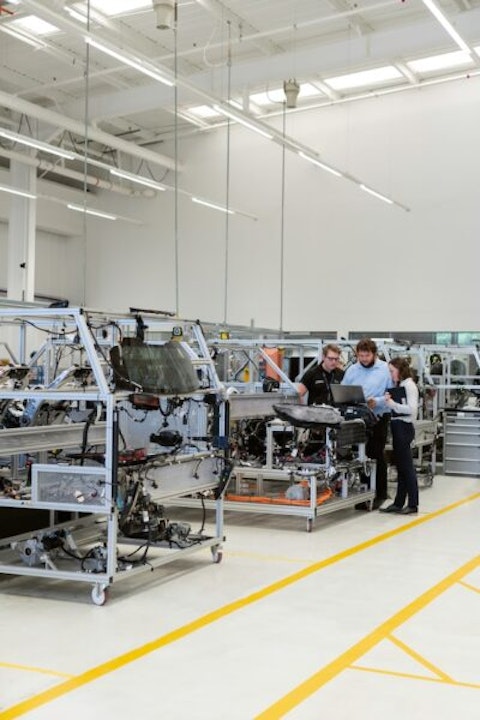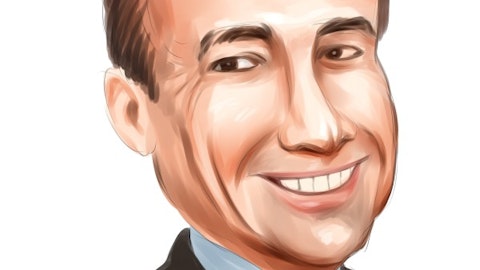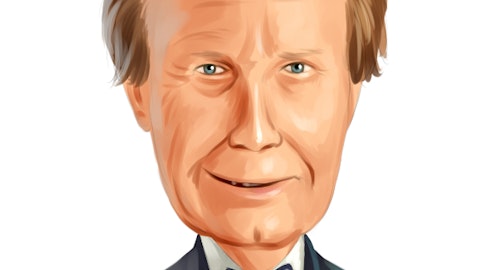Gentex Corporation (NASDAQ:GNTX) Q4 2022 Earnings Call Transcript January 27, 2023
Operator: Good day and thank you for standing by. Welcome to the Gentex Reports Fourth Quarter and Year-end 2022 Financial Results Conference Call. At this time, all participants are in a listen-only mode. After the speakers’ presentation, there will be a question and answer session. Please be advised that today’s conference is being recorded. And I would now like to hand the conference over to your speaker today, Mr. Josh O’Berski, Director of Investor Relations. Sir, please go ahead.
Josh O’Berski: Thank you. Good morning, and welcome to the Gentex Corporation Fourth Quarter 2022 Earnings Release Conference Call. I’m Josh O’Berski, Gentex’s Director of Investor Relations, and I am joined by Steve Downing, President and CEO; and Neil Bain, Vice President of Engineering and CTO; and Kevin Nash, Vice President of Finance and CFO. This call is live on the Internet and can be reached by going through the Gentex website and atir.gentex.com. All contents of this conference call are the property of Gentex Corporation and may not be copied, published, reproduced, rebroadcast, retransmitted, transcribed or otherwise redistributed. Gentex Corporation will hold responsible and liable any party for any damages incurred by Gentex Corporation with respect to any unauthorized use of the contents of this conference call.
This conference call contains forward-looking information within the meaning of the Gentex Safe Harbor statement included in the Gentex Reports Fourth Quarter 2022 financial results press release from earlier this morning and as always shown on the Gentex website. Your participation in this conference call implies consent to these terms. Now I’ll turn the call over to Steve Downing, who will get us started today. Steve?
Steve Downing: Thank you, Josh. For the fourth quarter of 2022, the company reported net sales of $493.6 million, an increase of 18% when compared to net sales of $419.8 million for the fourth quarter of last year. The fourth quarter of 2022 revenue included cost recoveries from customers of approximately $15 million. Light vehicle production increased by 7% quarter-over-quarter in the company’s primary markets of North America, Europe and Japan and Korea, which equates to an 11% revenue outperformance versus the company’s underlying markets. The gross margin in the fourth quarter of 2022 was 31.2%, compared with a gross margin of 34.3% in the fourth quarter of last year. The gross margin in the fourth quarter of 2022 was primarily impacted by raw material cost increases, unfavorable product mix and increased manufacturing costs stemming from labor cost increases and inefficiencies created by customer order volatility.
The cost increases were partially offset by cost recoveries during the quarter. The fourth quarter produced sequential improvements in gross margin of 140 basis points versus the third quarter of 2022 as a result of customer cost recoveries during the quarter, as well as some improvements in leveraging fixed costs. However, margins in the quarter were negatively impacted by sales that came in below our original forecast for the quarter, unfavorable product mix and increases in manufacturing costs. Heading into 2023, we continue to see strong demand for our products, which should result in record revenue performance for the year and will assist our ongoing efforts focused on margin recovery throughout 2023 and 2024. For the calendar year, we expect margins to begin the year in the range of the fourth quarter margin profile and then improve as the year progresses, ultimately ending at a weighted average margin of 32% to 33% for 2023.
Operating expenses during the fourth quarter of 2022 were up 7% to $59.7 million when compared to operating expenses of $56 million in the fourth quarter of last year. Income from operations for the fourth quarter of 2022 was $94.1 million, as compared to income from operations of $88 million for the fourth quarter of last year. During the fourth quarter of 2022, the company had an effective tax rate of 9.7%, which was driven by provision to return adjustments, as well as increased benefits from the foreign-derived intangible income deduction and discrete benefits from stock-based compensation. In the fourth quarter of 2022, net income was $86.2 million, as compared to net income of $84.2 million in the fourth quarter of 2021. Earnings per diluted share in the fourth quarter of 2022 were $0.37, as compared with earnings per diluted share of $0.35 in the fourth quarter of 2021.
For calendar year 2022, the company’s net sales were $1.92 billion, which was an increase of 11% compared to net sales of $1.73 billion in calendar year 2021 and represented the highest annual sales in company history. Light vehicle production in 2022 increased by 3% when compared to last year in the company’s primary markets, but total revenue for the year outperformed the underlying market by 8% despite the many supply chain challenges and customer order volatility encountered during the year. For calendar year 2022, the gross margin was 31.8%, compared to a gross margin of 35.8% for calendar year 2021. The largest impact to gross margin on a year-over-year basis were increased raw material costs, increased manufacturing costs, higher freight and logistics costs and certain previously agreed to annual customer price reductions.
For calendar year 2022, operating expenses increased 14% to $239.8 million, when compared to operating expenses of $209.9 million for last year. For calendar year 2022, the company’s effective tax rate was 13.8%, as compared to an effective tax rate of 13.3% last year. Net income for calendar year 2022 was $318.8 million, down 12% compared to net income of $360.8 million last year. Earnings per diluted share for calendar year 2022 were $1.36, compared to earnings per diluted share of $1.50 last year. I will now hand the call over to Kevin for fourth quarter financial details.
Kevin Nash: Thank you, Steve. Automotive net sales during the fourth quarter of 2022 were $482.9 million as compared to$409.6 million in the fourth quarter of 2021. For calendar year 2022, automotive net sales were $1.87 billion, which was a 10% increase over 2021. Other net sales in the fourth quarter, which includes simple aircraft windows and fire protection products were $10.7 million, an increase of 5% compared to other net sales of $10.2 million in the fourth quarter of 2021. Fire Protection sales increased by 37% for the fourth quarter of 2022when compared to the fourth quarter of 2021. Other net sales for calendar year 2022 were $44.2 million, compared to other net sales of $33.9 million in calendar year 2021. Fire protection sales in 2022 increased by 53% year-over-year, while dimmable aircraft window sales were down 33% in 2022 compared to calendar year 2021.
The company expects that dimmable aircraft window sales will continue to be impacted until there is a meaningful recovery of the aerospace industry and the Boeing 787 production levels improve. Share repurchases. The company repurchased 0.8 million shares of its account stock during the fourth quarter at an average price of $27.17 per share. For the year ended December 31 of 2022, the company repurchased 4.04 million shares of its common stock at an average price of $28.19 per share for a total of $113.9 million. As of December 31 of 22, the company has 20.8 million shares remaining available for repurchase pursuant to its previously announced share repurchase plan. The company intends to continue to repurchase additional shares of its common stock in the future in support of the previously disclosed capital allocation strategy, but share repurchases may vary from time to time and will take into account macroeconomic issues, market trends and other factors the company deems appropriate.

Photo by ThisisEngineering RAEng on Unsplash
Shifting over to the balance sheet. The items mentioned today are values as of December 31, of 2022 and are compared to December 31 of 2021. Cash and cash equivalents were $214.8 million, down from $262.3 million, primarily due to capital expenditures and cash flow from operations. Short-term and long-term investments combined were $176.9 million, down from $213.1 million. Accounts receivable was $276.5 million, up from $249.8 million due to the timing of sales within the quarter. Inventories were $404.4 million, which increased from $316.3 million, primarily in raw materials while up from December 31 of 2021 inventory levels have decreased sequentially from $418.3 million. The company continues to take a measured approach of inventory management as the supply chain constraints are starting to lessen and the company is looking at certain areas to reduce inventory levels.
However, customer order volatility still remains and forecasting in the short term remains challenging, so the company will continue to have higher levels of certain components to help manage risk and meet customer demand. And accounts payable increased to $151.7 million, up from $98.3 million primarily due to increased inventory purchases, capital expenditures and change in payment terms. Let’s take a look at preliminary cash flow items for the quarter and calendar year. Fourth quarter 2022 cash flow from operations was $101.8 million, which was an increase from $69.1 million in the fourth quarter of 2021 and year-to-date cash flow from operations was $338.2 million, compared to $362.2 million for calendar year 2021. Capital expenditures for the fourth quarter were $38 million, compared with $30.8 million for the fourth quarter of 2021 and calendar year 2022 capital expenditures were $146.4 million, compared to $68.8 million for calendar year 2021.
And depreciation and amortization for the fourth quarter was $23.3 million, compared to $24 million for the fourth quarter of 2021 and calendar year 2022 depreciation and amortization was $96.6 million, compared with $99.1 million for calendar year 2021. I’ll now hand the call over to Neil for a product update.
Neil Boehm: Great. Thanks, Kevin. Earlier this month, Gentex participated in the 2023 Consumer Electronics Show. We utilized CES to showcase our current and potential future product portfolio. Our booth was designed to help automakers envision a path toward the autonomous age with scalable products and features ready for implementation on today’s vehicles. . This year at CES, our automotives and aerospace customers were able to experience Gentex technologies in new and exciting ways. We displayed advanced vehicle and aircraft fuselage simulators that allow those attendants to experience firsthand the benefits of our technology right on the show floor. Our unique vehicle demonstrator showcased a scalable yet holistic approach to driver and in-cabin monitoring.
The driver monitoring system track the driver’s head pose and monitoring. The driver monitoring system track the driver’s head pose eye gaze and other relevant movements to determine distraction, drowsiness, sudden sickness and readiness for the return of manual control in semiautonomous vehicles. This system is easily expandable to include 2D and 3D cabin monitoring for detecting passengers, behaviors, objects and even presence of life. Our goal with this system is to provide solutions for today’s vehicles and the transition to autonomous vehicles and that means engineering a comprehensive and scalable monitoring platform based on our competency in digital vision and sensor fusion techniques. Our CES booth also highlighted the company’s industry-leading Full Display Mirror, an intelligent rear vision system that uses a custom camera and mirror-integrated video display to optimize a vehicle’s rearview vision.
The FDM also serves as a platform for additional innovation. Add-on features that we demonstrated included a mirror integrated digital video recorder, scalable trailer cam system, touchscreen display, lane line projection overlays and mirror integrated camera for video conferencing or capturing photos within the vehicle cabin. Also displayed at CES were large area dimmable devices including Sunroofs that darken on-demand or with system intelligence. And Sun visors that fold down like a traditional visor but include a clear dimmable panel that can darken on demand based on sun load. We also highlighted small scalable dimmer devices that have many different use cases, including the ability to darken and improve contrast and visibility for transparent displays, consuming of sensors and dynamic adjustment of camera exposure.
Many of the products that we initially developed for the automotive industry are built on technology platforms and can be customized for other industries. For CES 2023, Gentex developed an aircraft fuselage simulator that allowed us to demonstrate how these same technologies can be deployed into aerospace. These technologies included dimmable glass and smart lighting, where we utilize the camera system to control the location and color temperature of cabin lighting. Few slides also showed various dimmable devices, including our dimmable windows and further advancements in this technology for dimmable partition devices to create privacy and cabin separators. We also included various biometric systems where we demonstrated the use of facial recognition to create a personal experience for the passenger and then utilize iris-based biometrics for a more accurate identification of a passenger for secured transactions.
These technologies can make the flight experience safer, more enjoyable and more personalized. Overall, CES 2023 was an excellent opportunity for us to demonstrate to our current and hopefully, some future customers. What is driving our business today and what things we’re working on to drive our growth in the coming years. In terms of launches, for the fourth quarter of 2022, there were 27 net new nameplate launches of our interior and exterior auto-dimming mirrors and electronic features. Approximately 50% of these new nameplate launches were advanced features with Full Display Mirror and HomeLink leading the way. Now for an update on Full Display Mirror. During the fourth quarter of 2022, we began shipping FDM on seven new vehicle nameplates.
These new vehicle nameplates are, the Chevy Bolt EUV, the Kia Telluride. The Mercedes Sprinter, the Subaru Soltera, the Lexis Rx, the Toyota Prius and Toyota Sequoia. Including these seven new nameplates in 2022, Gentex began shipping FDM on 18 nameplates, and are currently shipping FDM on 86 nameplates. The technology continues to have growing interest and growth potential and we are excited to see how well this product is being received by our OEM customers and the end consumers. 2022 is an extremely challenging year, but the teams at Gentex did an outstanding job executing the high volume and extremely complex new launches that have been driving our new business growth, all while managing through the product redesigns that have been necessary due to component shortages that our industry has been facing.
As we look forward, our launch rates continue to look strong and as we continue to come out of this redesign cycle, I am excited about our ability to refocus all of our development efforts to new products and technologies. I’ll now hand the call back over to Steve for guidance and closing remarks.
Steve Downing: Thanks, Neil. The company’s current forecast for light vehicle production for calendar year 2023 and 2024 are based on the S&P Global Mobility mid-January 2023 forecast for light vehicle production in North America, Europe, Japan, Korea and China and can be found in our press release. For calendar year 2023, light vehicle production in these markets is forecasted to increase 4% when compared to calendar year 2022 and is estimated to increase an additional 4% for calendar year 2024. Based on this light vehicle production forecast, the company is providing the following estimates for 2023. Revenue for the year is expected to be approximately $2.2 billion. Gross margins for the year are expected to be between 32% and 33%.
Operating expenses are expected to be between $260 million and $270 million. Our estimated annual tax rate is forecasted to be between 15% and 17%. Capital expenditures are expected to be between $200 million and $225 million. The company intentionally delayed capital expenditures in 2020 and 2021, given the mandated shutdowns and the industry downturn. During 2022, the intent was to spin that previously delayed capital However, availability of materials and capital equipment further delayed that spend. As a result, 2023 and 2024 CapEx will be higher than our typical rate, but represents the level of spend needed to support the book business driving our growth and future R&D projects. Lastly, depreciation and amortization is forecasted to be between $100 million and $110 million for 2023.
Additionally, based on the company’s current forecast for light vehicle production for calendar year 2024, the company expects calendar year 2024 revenue growth of approximately 10% above the 2023 revenue guidance range of approximately $2.2 billion. Calendar year 2022 will be remembered as a very difficult operating environment that was negatively impacted by customer order volatility, supply and component constraints, cost deflation and raw components, labor and almost every other facet of the business. As we look into 2023, we are working hard to make sure that this coming year will be remembered as the year where we broke through the $2 billion revenue threshold and continued the process of improving the margin profile of the business. While we fully anticipate continued margin pressure for the first half of 2023, we also expect that the margin will improve throughout the year with the work done this year, setting the stage for further margin improvement throughout 2024.
While there may be some lingering effects from supply and labor constraints that could limit global light vehicle production growth rates, we still believe our forecasted growth rate, in combination with our focus on cost control and other margin improvement efforts will move us to our targeted margin profile of 35% to 36% by the end of 2024. Our current model for the next two years includes an improving revenue environment driven by our product portfolio, as well as improving margins from a better supply environment and internal cost control. These factors we believe will result in record revenue and improved margin performance that should result in increasing shareholder returns over the next two years. That completes our prepared comments for today.
Thank you for your time and we can now proceed to questions.
See also 11 Most Undervalued Foreign Stocks To Buy and 15 Most Undervalued NASDAQ Stocks.
Q&A Session
Follow Gentex Corp (NASDAQ:GNTX)
Follow Gentex Corp (NASDAQ:GNTX)
Operator: Our first question will come from Luke Junk of Baird. Your line is open.
Luke Junk: Good morning. Thanks for taking my question. I want to start with gross margin this morning. Good to see the initial cost recoveries flowing in here in the quarter. Now that you’ve been having a lot of those conversations and relative to what you’re guiding for 2023, how good is your line of sight to that level of gross margin at 32% to 33% or said differently, how much do you already have in hand versus negotiations that are still undergoing at this point? Thank you.
Steve Downing: Yes. For the first quarter, we feel pretty good about where we’re at on the recovery side to get to that range for the year. Like we mentioned in the prepared comments, we think the first quarter is going to look a little bit more like Q4 from an overall margin percentage perspective. But a lot of these recovery will start to take effect throughout the year and the growth rate will obviously help with the overhead side to help leverage the business to get to that range for the full year.
Luke Junk: Maybe just to follow up on that, specifically, the negotiations themselves, Steve, is that still ongoing? Or what’s reflected in the guidance is more so leaning towards things that you’ve already agreed to with customers.
Steve Downing: Yes. The guidance is really about 60% to 70% of what’s needed to hit that range or already agreed to. We do have several customers that are still outstanding that we need to reach agreement with.
Luke Junk: Okay. That’s helpful. Thank you for that data point. And then my follow-up question on FDM and then kudos to your supply chain, your engineering team for what is I mean, I think it’s understated to say a very impressive result in2022, but is it right to think that may still have been short of where take rates from your customers were last year? And along those lines, does this rebase your expectations for FDM unit growth going forward? And maybe if you could comment what’s in the guidance as well. Thank you.
Steve Downing: Yes. So the take rates didn’t worsen because of that. Really what happened though is they were increasing throughout the year. What I would say is FDM shipments in 2022 were probably 100,000 to 150,000 units short of what customers would have liked them to be, and that was driven almost exclusively by availability of components. And to your point, and thanks for thanks for recognizing and pointing that out, but Neil’s team did an incredible job of even the work to even get to this level was Herculean. So it was a pretty crazy year in terms of how much work had to go in just to try to get to this level of performance. In terms of going forward, we’ve been talking 200,000 to 300,000 units per year is kind of what our expected growth rate was over a longer period. I actually think ’23 will be slightly above that, so probably north of the 300,000 unit range going into 2023.
Luke Junk: Thank you for that. I’ll leave it there.
Steve Downing: Thanks Luke.
Operator: Thank you. One moment please for our next question. Our next question will come from David Kelley of Jefferies. Your line is open.
David Kelley: Hey good morning, guys. Thanks for taking my questions. Maybe to follow up on the gross margin discussion and appreciate also the color on cost recoveries but the other impacts in the quarter, raw material labor cost increases, can you give us a sense of the impact there. And then I also wanted to ask about the order volatility in the quarter. Is that still supply chain constraint related?





